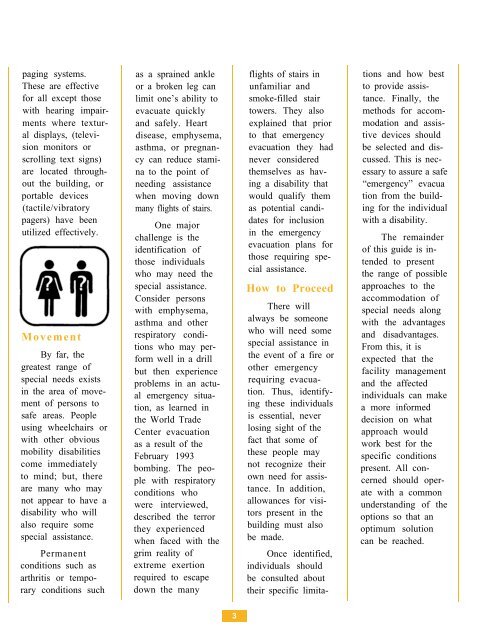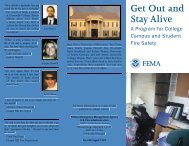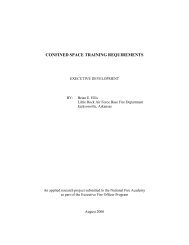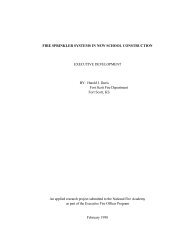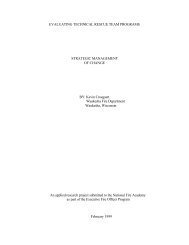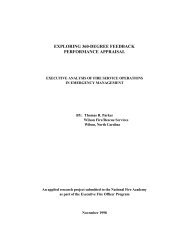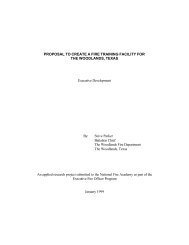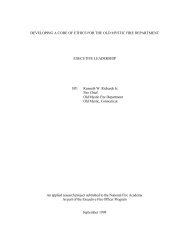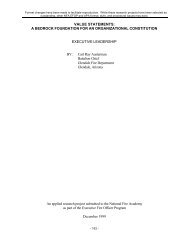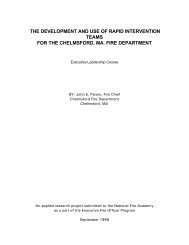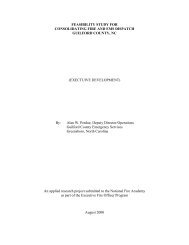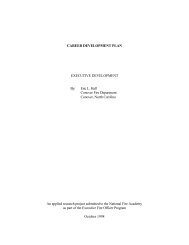Emergency Procedures for Employees with Disabilities - US Fire ...
Emergency Procedures for Employees with Disabilities - US Fire ...
Emergency Procedures for Employees with Disabilities - US Fire ...
You also want an ePaper? Increase the reach of your titles
YUMPU automatically turns print PDFs into web optimized ePapers that Google loves.
paging systems.<br />
These are effective<br />
<strong>for</strong> all except those<br />
<strong>with</strong> hearing impairments<br />
where textural<br />
displays, (television<br />
monitors or<br />
scrolling text signs)<br />
are located throughout<br />
the building, or<br />
portable devices<br />
(tactile/vibratory<br />
pagers) have been<br />
utilized effectively.<br />
Movement<br />
By far, the<br />
greatest range of<br />
special needs exists<br />
in the area of movement<br />
of persons to<br />
safe areas. People<br />
using wheelchairs or<br />
<strong>with</strong> other obvious<br />
mobility disabilities<br />
come immediately<br />
to mind; but, there<br />
are many who may<br />
not appear to have a<br />
disability who will<br />
also require some<br />
special assistance.<br />
Permanent<br />
conditions such as<br />
arthritis or temporary<br />
conditions such<br />
as a sprained ankle<br />
or a broken leg can<br />
limit one’s ability to<br />
evacuate quickly<br />
and safely. Heart<br />
disease, emphysema,<br />
asthma, or pregnancy<br />
can reduce stamina<br />
to the point of<br />
needing assistance<br />
when moving down<br />
many flights of stairs.<br />
One major<br />
challenge is the<br />
identification of<br />
those individuals<br />
who may need the<br />
special assistance.<br />
Consider persons<br />
<strong>with</strong> emphysema,<br />
asthma and other<br />
respiratory conditions<br />
who may per<strong>for</strong>m<br />
well in a drill<br />
but then experience<br />
problems in an actual<br />
emergency situation,<br />
as learned in<br />
the World Trade<br />
Center evacuation<br />
as a result of the<br />
February 1993<br />
bombing. The people<br />
<strong>with</strong> respiratory<br />
conditions who<br />
were interviewed,<br />
described the terror<br />
they experienced<br />
when faced <strong>with</strong> the<br />
grim reality of<br />
extreme exertion<br />
required to escape<br />
down the many<br />
3<br />
flights of stairs in<br />
unfamiliar and<br />
smoke-filled stair<br />
towers. They also<br />
explained that prior<br />
to that emergency<br />
evacuation they had<br />
never considered<br />
themselves as having<br />
a disability that<br />
would qualify them<br />
as potential candidates<br />
<strong>for</strong> inclusion<br />
in the emergency<br />
evacuation plans <strong>for</strong><br />
those requiring special<br />
assistance.<br />
How to Proceed<br />
There will<br />
always be someone<br />
who will need some<br />
special assistance in<br />
the event of a fire or<br />
other emergency<br />
requiring evacuation.<br />
Thus, identifying<br />
these individuals<br />
is essential, never<br />
losing sight of the<br />
fact that some of<br />
these people may<br />
not recognize their<br />
own need <strong>for</strong> assistance.<br />
In addition,<br />
allowances <strong>for</strong> visitors<br />
present in the<br />
building must also<br />
be made.<br />
Once identified,<br />
individuals should<br />
be consulted about<br />
their specific limita-<br />
tions and how best<br />
to provide assistance.<br />
Finally, the<br />
methods <strong>for</strong> accommodation<br />
and assistive<br />
devices should<br />
be selected and discussed.<br />
This is necessary<br />
to assure a safe<br />
“emergency” evacua<br />
tion from the building<br />
<strong>for</strong> the individual<br />
<strong>with</strong> a disability.<br />
The remainder<br />
of this guide is intended<br />
to present<br />
the range of possible<br />
approaches to the<br />
accommodation of<br />
special needs along<br />
<strong>with</strong> the advantages<br />
and disadvantages.<br />
From this, it is<br />
expected that the<br />
facility management<br />
and the affected<br />
individuals can make<br />
a more in<strong>for</strong>med<br />
decision on what<br />
approach would<br />
work best <strong>for</strong> the<br />
specific conditions<br />
present. All concerned<br />
should operate<br />
<strong>with</strong> a common<br />
understanding of the<br />
options so that an<br />
optimum solution<br />
can be reached.


